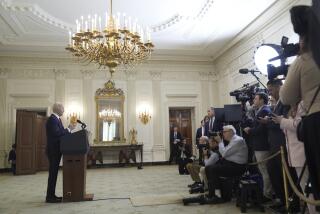Detroit Papers Held Back From Turning Eager Losses Into Monopoly Profits
- Share via
Once upon a time, when a newspaper operated at a loss its owner might have considered the subsidy to be money well spent. The paradigm here is the scene in Orson Welles’ “Citizen Kane” in which the business manager reports with alarm that the paper has been losing a million dollars a year. At that rate, publisher Charles Foster Kane replies slyly, “I’ll have to close this place in 60 years.”
These days, when most newspapers have no proprietors and their fates are decided by business managers and financial analysts, a paper that loses a hundred bucks in two quarters running is likely to earn the epithet “now-defunct.”
Either that or it will become instantly and effortlessly rich, courtesy of the Newspaper Preservation Act. This 1971 law, designed to overturn a court decision holding the Tucson newspapers accountable under the antitrust laws, allows competing newspapers to combine non-editorial operations if one of them can persuade the attorney general of the United States that it is in danger of failing economically.
The resulting joint operating agreement, or JOA, typically creates a monopoly enterprise whose suddenly huge and virtually guaranteed profits are divided up according to a fixed formula between the previously competitive publishers. In the nature of things, the newspapers raise their subscription prices and advertising rates but fail to provide any more editorial product or market coverage than before. The recent editorial resurgence of Hearst’s San Francisco Examiner is a remarkable exception that tests the rule.
The law obviously creates the temptation for publishers in the few remaining competitive cities to claim hardship, in the expectation that a guaranteed share of monopoly profits will be larger than 100% of profits earned in the free market.
In Detroit, where the nation’s two largest media conglomerates have been duking it out for dominance in the market, the rival newspapers claim to have lost $140 million between them since 1981, and have asked for approval of a joint operating agreement. The Detroit News, which is owned by Gannett Co., has held a small circulation lead over the Free Press, owned by Knight-Ridder Inc. Since advertising tends to gravitate disproportionately to the more successful of two competing papers, the Free Press says that it is doomed to fail if the government doesn’t allow the merger. If the Free Press folds, one of the nation’s best news organizations will fall silent and Detroit will lose a major employer. With the joint operating agreement, the two papers’ losses would turn quickly into millions in profits.
Last September the antitrust division of the Justice Department urged the attorney general not to approve the merger. Last week an administrative law judge who independently reviewed the proposed JOA also recommended that it be disallowed.
Judge Morton Needelman concluded that the newspapers’ losses were not inevitable but resulted from promotional spending and underpricing to support “strategies of seeking market dominance and future profitability at any cost.” Managers ran up red ink, he said, “with the expectation that failure to achieve these goals would result in favorable consideration of a joint operating agreement application.”
Consider, for example, a simple matter of nickels and dimes.
With the price of newsprint at $650 a metric ton as of Jan. 1, a typical one-pound edition of, say, the Chicago Tribune now contains 29.5 cents worth of paper. But you can buy the Tribune on any street corner for 25 cents. That’s typical. According to the American Newspaper Publishers Assn., of 1,659 general-circulation dailies, 466 (28%) sell for 30 cents or more, 1,124 (68%) sell for 25 cents and only 69 (4%) sell for 20 cents or less.
Only two of those 69, the Detroit papers, are in a major market. The weighty Free Press sells for 20 cents, and the equally hefty Detroit News for 15 cents. It appears that readers are very nearly getting something for nothing.
A 25-cent cover price on daily editions would in the abstract produce an additional $9.9 million a year for the Free Press and $20.1 million for the News--not counting Sunday sales. Even with considerable circulation slippage, revenues from realistic pricing would have more than covered the claimed $140 million in losses over seven years.
Atty. Gen. Edwin Meese III, who must make the final decision in this matter, has promised to do so expeditiously. He will be under severe political pressure. How strong that pressure can be was indicated when the Newspaper Preservation Act was being debated back in 1970: Even Vice President Spiro T. Agnew, who had made his reputation attacking concentration of power in the media, suddenly found himself defending the publishers’ position. But perhaps the Reaganites will be stronger in their free-market faith.
More to Read
Inside the business of entertainment
The Wide Shot brings you news, analysis and insights on everything from streaming wars to production — and what it all means for the future.
You may occasionally receive promotional content from the Los Angeles Times.










